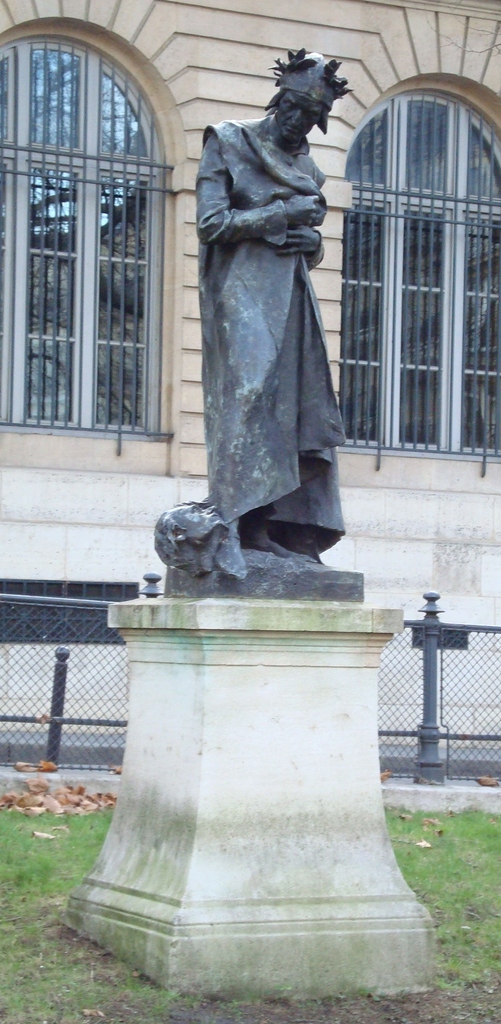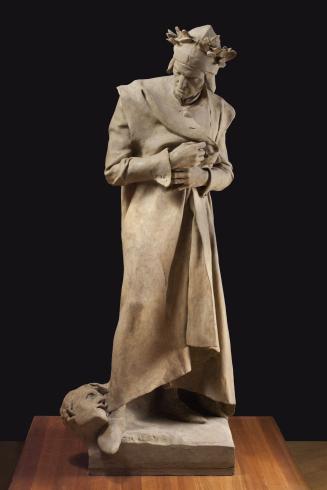Following two gold medals at the Salons of 1874 and 1876, the sculptor Jean-Paul Aubé won great success once again at the Salon of 1879 with this full-length portrait of the famous Florentine poet and politician Dante Alighieri (1265-1321), author of The Divine Comedy. A pupil of Antoine Laurent Dantan and Francisque Duret at the École des Beaux-Arts de Paris, Aubé travelled to Italy in 1866, where he developed a taste for the Renaissance Revival style.
The Divine Comedy, composed between 1303 and 1321 and published for the first time in 1555, recounts the imaginary voyage of the narrator, who finds himself suddenly plunged into a dark forest. There he meets the Latin poet Virgil who will serve as his guide in the course of his journey. This monumental work, both intellectual and spiritual, is presented as a voyage of initiation through the three realms of afterlife: Hell, Purgatory and Paradise. It combines an account of Dante’s personal journey with a theological reflection on the search for eternal salvation. The long poem was a major source of inspiration for artists of the Romantic generation, such as Delacroix, William Blake and Gustave Doré. It continued to fascinate sculptors in the second half of the 19th century, in particular Carpeaux (Ugolino, Petit Palais) and Rodin (La Porte de l’Enfer, Rodin Museum).
Here, Aubé depicts Dante repelling with his right foot the head of a damned soul representing the forces of evil. The scene is taken from Canto XXXII of the Inferno: having arrived at the ninth and final circle of Hell, the poet and his guide walk across a frozen lake in which shiver the souls of betrayers. After crossing “Caina”, the area for betrayers of their own kin, they reach “Antenora”, the area for betrayers of their homeland. Dante then strikes with his foot the head of a damned soul, Bocca degli Abati:
 « And while we were advancing towards the middle
« And while we were advancing towards the middle
Where everything of weight unites together,
And I was shivering in the eternal shade,
Whether ’twere will, or destiny, or chance,
I know not; but in walking ’mong the heads,
I struck my foot hard in the face of one.
Weeping he growled: “Why dost thou trample me?
Unless thou comest to increase the vengeance
of Montaperti, why dost thou molest me? »
Dante is represented here with his traditional attributes, the long coat, the hanging chaperon, and the laurel wreath of poets. The drapery, treated in summary fashion in large swaths, contrasts with the highly expressive physiognomy of the figure, and with his taut hands attempting to lift the hem of his attire. The work is constructed along a powerful line of action connecting the gazes of the damned soul and the main figure. The City of Paris bought this plaster model from the artist in order to have a bronze statue made (cast by H. Moltz), located since 1882 on Place Marcelin-Berthelot, in front of the Collège de France. The statue was also successfully presented at the Universal Expositions of Vienna, in 1882, and Paris, in 1889 and 1900.
H. D.

City of Paris municipal collection's website
The collections portal can be used to search the collections of Paris’s 14 municipal museums (approximately 336,000 works, including 43,000 belonging to the Petit Palais).
It is also possible to download around 12,000 images of the museum’s works free of charge.
Access the Museums of the City of Paris collections portal
Extern databases
Discover a selection of databases online presenting works from the Petit Palais or documents concerning the history of the museum.

